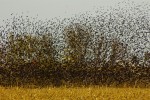Passenger Pigeons

by Sandra Merville Hart
Passenger pigeons were once so numerous in the United States that they made up 25% to 40% of all the birds in our country. There are estimates that between 3 billion and 5 billion passenger pigeons were here around the time of Christopher Columbus. Sadly, these birds have all died and are now extinct.
Darkened the Sky
These birds flew in huge flocks. There were so many pigeons flying overhead that they darkened the sky for hours. With a great cloud of birds about a mile wide and up to 300 miles long, they sometimes blocked the sun from morning to evening for several days.
Very fast
Passenger pigeons flew very fast. It is estimated they flew about sixty miles an hour, which is around the speed limit on the highway.
Passenger pigeons searched for large forests to build nests in the trees. Because they traveled in such large numbers, hundreds of nests could be in a single tree. One nesting area in Wisconsin covered about 850 square miles with about 136,000,000 birds.
The forests provided acorns, chestnuts, beechnuts, and fruit for the pigeons.
Professional hunters
Unfortunately, professional hunters captured them in nets and shot them to sell in markets. By 1860, the population of the pigeons had shrunk, but hunters still sold them to markets.
Martha
Martha was the last known passenger pigeon and lived at the Cincinnati Zoological Garden. She died on September 1, 1914.
Sources
“Passenger Pigeon,” Chipper Woods Bird Observatory, 28 October 2012, <http://www.wbu.com/chipperwoods/photos/passpigeon.htm>
“‘The Passenger Pigeon,” Encyclopedia Smithsonian, 28 October 2012, <http://www.si.edu/encyclopedia_Si/nmnh/passpig.htm>







0 Comments
Trackbacks/Pingbacks